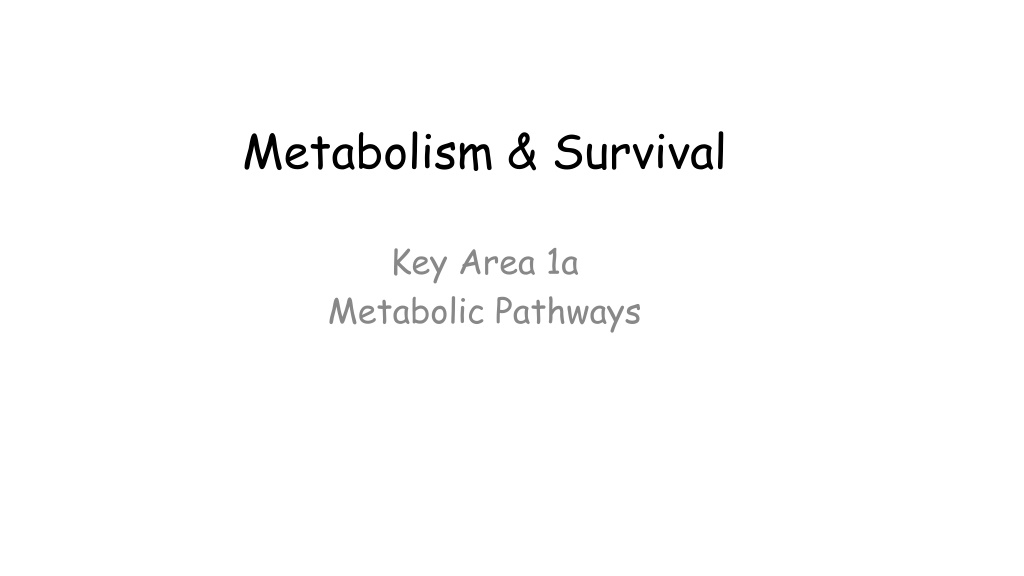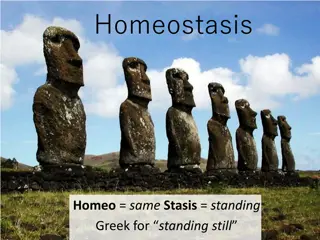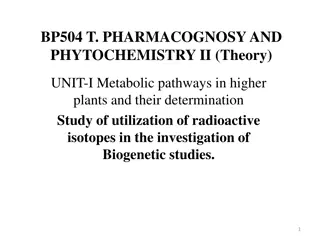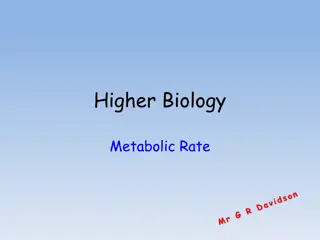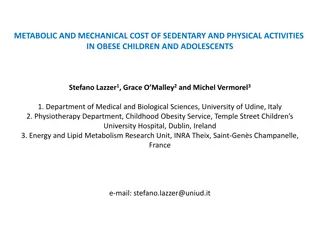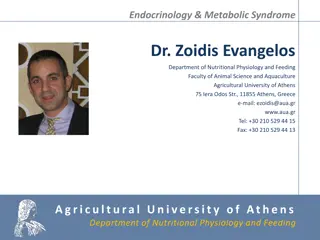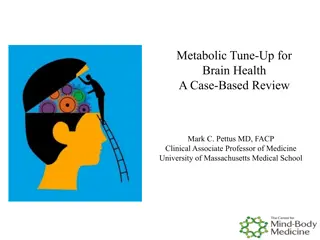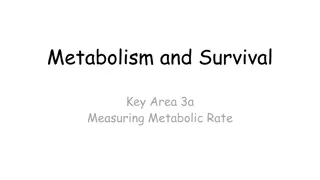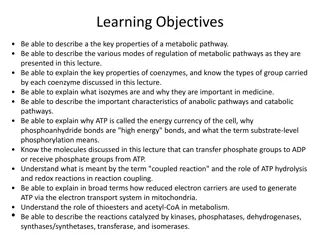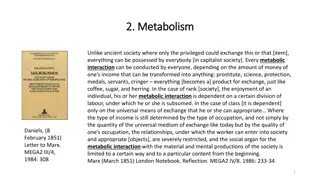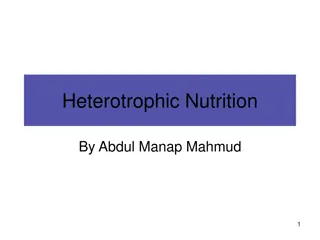Understanding Metabolic Pathways in Organisms
Exploring the intricate world of metabolism, this topic delves into the chemical reactions within organisms. From anabolic to catabolic pathways, enzymes play a crucial role in controlling these processes. Learn about reversible and irreversible reactions, alternative pathways, and the vital role of ATP in energy transfer within cells.
Download Presentation

Please find below an Image/Link to download the presentation.
The content on the website is provided AS IS for your information and personal use only. It may not be sold, licensed, or shared on other websites without obtaining consent from the author. Download presentation by click this link. If you encounter any issues during the download, it is possible that the publisher has removed the file from their server.
E N D
Presentation Transcript
Metabolism & Survival Key Area 1a Metabolic Pathways
Learning Intentions By the end of this topic you should be able to: Understand that metabolism is the sum total of all chemical reactions taking place within an organism Describe how reactions occur in sequences, each one mediated by a specific enzyme Describe these sequences as pathways and explain how they are linked and may be reversed Explain the differences between anabolic and catabolic pathways
Anabolic and Catabolic Reactions Reversible and Irreversible reactions Alternative Pathways
You should already know that: The cell membrane consists of lipids and proteins and is selectively permeable Enzymes speed up cellular reactions and are unchanged in the process
Metabolism All of the chemical reactions that take place in the cell make up the cells metabolism It involves reversible and irreversible steps (sometimes with alternative routes) and it is all controlled by enzymes
Metabolic Pathways Metabolic pathways are integrated and controlled pathways of enzyme-catalysed reactions within a cell. There are 2 types of reaction within a metabolic pathway Anabolic and Catabolic
Anabolic & Catabolic Reactions Reactions that build up large complex molecules from simpler smaller molecules are known as anabolic reactions and so require energy. Reactions that break down large complex molecules into simpler smaller molecules are known as catabolic reactions and so release energy. Energy is moved in cells in the form of ATP
The two types of metabolic pathway Protein Glucose + oxygen anabolic pathway catabolic pathway energy CO2 + water Amino acids
Activation Energy Without an enzyme or catalyst the energy needed to start the reaction is large and so the reaction is slow With an enzyme, the energy required is lowered and the reaction is quicker or it can take place at a lower temperature
Consider the following metabolic pathway: Gene(s) Gene(s) Enzyme 1 Enzyme 2 Metabolite B Metabolite C Metabolite A Each step is driven by a specific enzyme Each enzyme is coded for by a gene or genes. If the correct enzyme is present then the pathway proceeds.
Consider the following metabolic pathway: Gene(s) Gene(s) Enzyme 2 x Enzyme 1 Metabolite C x Metabolite B Metabolite A If one enzyme is absent the pathway will stop. Enzyme action can be regulated by the level of gene expression .if the gene does not function/is not expressed correctly then the enzyme is not produced
Respiration Example glucose Enzyme A Starch (plants) intermediate 1 Glycogen (mammals) Enzyme B intermediate 2 Enzyme C intermediate 3 Many steps, many enzymes pyruvate
Reversible and irreversible steps Enzyme A Glucose Intermediate 1 IRREVERSIBLE Glucose diffuses from a high concentration outside the cell to a low concentration inside the cell, then it is converted to intermediate 1. This reaction is irreversible It is of benefit to the cell as it maintains a low concentration of glucose inside the cell and therefore allows glucose to diffuse constantly into the cell.
Reversible and irreversible steps Glycogen (mammals) Enzyme B Intermediate 1 Intermediate 2 REVERSIBLE Starch (plants) The conversion of Intermediate 1 to Intermediate 2 is reversible. If more intermediate 2 if formed than the cell needs for the next step then some can changed back into intermediate 1 and used in alternative pathway e.g to build glycogen in animal cells or starch in plant cells.
Reversible and irreversible steps Enzyme C Intermediate 2 Intermediate 3 IRREVERSIBLE The conversion of Intermediate 2 to Intermediate 3 is irreversible. Intermediate 3 will always be converted to pyruvate (through many further steps).
Alternative routes glucose Enzyme A Pathways can be modified and contain alternative routes, so steps can be bypassed. Alternative route intermediate 1 Enzyme B intermediate 2 sorbitol Enzyme C intermediate 3 Many steps, many enzymes pyruvate
Alternative routes Enzymes often work in groups or as multi-enzyme complexes as it allows many complex steps to be undertaken and ensures a higher concentration of substrates close to the specific enzyme active sites glucose Enzyme A Alternative route intermediate 1 Enzyme B intermediate 2 sorbitol Enzyme C intermediate 3 Many steps, many enzymes pyruvate
